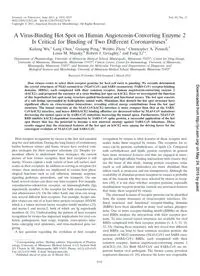
2011 A Virus-Binding Hot Spot on Human Angiotensin-Converting Enzyme 2 Is Critical for Binding of Two Different Coronavi PDF
Preview 2011 A Virus-Binding Hot Spot on Human Angiotensin-Converting Enzyme 2 Is Critical for Binding of Two Different Coronavi
JOURNAL OF VIROLOGY, June 2011, p. 5331–5337 Vol. 85, No. 11 0022-538X/11/$12.00 doi:10.1128/JVI.02274-10 Copyright © 2011, American Society for Microbiology. All Rights Reserved. A Virus-Binding Hot Spot on Human Angiotensin-Converting Enzyme 2 Is Critical for Binding of Two Different Coronaviruses� Kailang Wu,1 Lang Chen,1 Guiqing Peng,1 Wenbo Zhou,2 Christopher A. Pennell,3 Louis M. Mansky,4 Robert J. Geraghty,2 and Fang Li1* Department of Pharmacology, University of Minnesota Medical School, Minneapolis, Minnesota 554551; Center for Drug Design, University of Minnesota, Minneapolis, Minnesota 554552; Cancer Center, Center for Immunology, University of Minnesota, Minneapolis, Minnesota 554553; and Institute for Molecular Virology and Departments of Diagnostic and Biological Sciences and Microbiology, University of Minnesota Medical School, Minneapolis, Minnesota 554554 Received 29 October 2010/Accepted 2 March 2011 How viruses evolve to select their receptor proteins for host cell entry is puzzling. We recently determined the crystal structures of NL63 coronavirus (NL63-CoV) and SARS coronavirus (SARS-CoV) receptor-binding domains (RBDs), each complexed with their common receptor, human angiotensin-converting enzyme 2 (hACE2), and proposed the existence of a virus-binding hot spot on hACE2. Here we investigated the function of this hypothetical hot spot using structure-guided biochemical and functional assays. The hot spot consists of a salt bridge surrounded by hydrophobic tunnel walls. Mutations that disturb the hot spot structure have significant effects on virus/receptor interactions, revealing critical energy contributions from the hot spot structure. The tunnel structure at the NL63-CoV/hACE2 interface is more compact than that at the SARS- CoV/hACE2 interface, and hence RBD/hACE2 binding affinities are decreased either by NL63-CoV mutations decreasing the tunnel space or by SARS-CoV mutations increasing the tunnel space. Furthermore, NL63-CoV RBD inhibits hACE2-dependent transduction by SARS-CoV spike protein, a successful application of the hot spot theory that has the potential to become a new antiviral strategy against SARS-CoV infections. These results suggest that the structural features of the hot spot on hACE2 were among the driving forces for the convergent evolution of NL63-CoV and SARS-CoV. Host receptor recognition by viruses is the first and essential step for viral infections. During the long history of evolutionary battles between viruses and hosts, viruses have evolved com- plex strategies for their receptor selections (2). Despite tre- mendous efforts to understand these strategies, the current picture of how viruses recognize their host receptors is still murky. Viruses exploit a wide variety of host cell surface mol- ecules as their receptors. In addition to serving as receptors for viruses, these molecules are implicated in various host physi- ological functions such as cell adhesion, immune response, signaling pathways, proteolysis, and ion transport. On one hand, several viruses can share one host receptor. For example, coxsackievirus-adenovirus receptor, an immunoglobulin (Ig) superfamily member, is the receptor for both coxsackieviruses and adenoviruses (3). On the other hand, one virus can recog- nize several different host receptors. For example, herpes sim- plex viruses use one of at least three protein receptors: HVEM, which is a tumor necrosis factor receptor family member (23), and nectin-1 and nectin-2, both of which are Ig superfamily members (8, 31). Understanding the pattern of host receptor recognition by viruses has important implications for viral evo- lution, pathogenesis, host range, tropism, cross-species infec- tions, emerging viral epidemics, and virus-mediated gene tar- geting. A key question regarding the evolution of host receptor recognition by viruses is what features of these receptor mol- ecules make them targeted by viruses. The receptors for vi- ruses can be proteins, carbohydrates, or lipids (2). Compared with carbohydrates and lipids, protein receptors in general have more structural features and thus are engaged in more- specific and high-affinity binding interactions with viruses; they are the focus of this study. Among protein receptors, some (such as cell adhesion molecules) are more abundant than others (such as proteases and ion transporters). Although the availability of abundant protein receptors to viruses is probably one of the reasons why they were selected by viruses as recep- tors (30), it is not clear whether receptor proteins, especially nonabundant receptor proteins, contain any structural features that make them targeted by viruses. The structural features of receptor proteins can be identified from the atomic structures of virus/receptor interfaces. De- fined structural and functional receptor-binding domains (RBDs) have been identified in many viral surface glycopro- teins. One or more receptor-binding motifs (RBMs) on these viral RBDs mediate the interactions with their receptor pro- teins. To date several crystal structures are available for viral RBDs complexed with their receptor proteins (1, 4, 5, 13, 18, 32, 33). Among these structures, only two reveal how different viral RBDs can bind to their common receptor protein: the structures of NL63 coronavirus (NL63-CoV) and SARS coro- navirus (SARS-CoV) RBDs, each complexed with their common receptor, human angiotensin-converting enzyme 2 (hACE2) (18, 32). Both NL63-CoV and SARS-CoV are im- portant human viral pathogens. The former causes prevalent respiratory diseases (6, 29), whereas the latter was responsible * Corresponding author. Mailing address: Department of Pharma- cology, University of Minnesota Medical School, 6-121 Jackson Hall, 321 Church St. SE, Minneapolis, MN 55455. Phone: (612) 625-6149. Fax: (612) 625-8408. E-mail:
